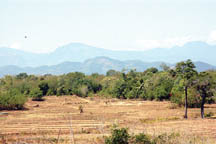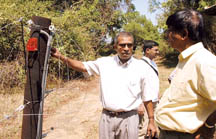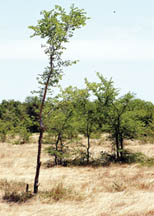|
DAILY NEWS ONLINE |
|
|
|
OTHER EDITIONS |
|
|
|
|
|
|
|
|
|
OTHER LINKS |
|
|
|
|
|
|
  |
A Peace Retreat in the wilds
Wasgomuwa National Park is an yet to be discovered haven which could provide solace to a tired mind and an atmosphere for meditation and relaxation. This is a place to which one could `retreat' and be at peace with oneself and nature. An ideal jungle hideout from the busy helter skelter life in the cities. Dayananda Kariyawasam aptly described that Wasgomuwa with its idyllic surroundings could provide `spiritual peace' through retreat which has been scientifically proved. He said that Wasgomuwa is a place to relax. It is an `Aramaya' for those who thirst for solitude. The concept `retreat' is faithfully followed in India and the Yellow Stone Park in the United States is another ideal`retreat' venue. Wasgomuwa National Park (WNP) with its archaeological and historical background has been brought under the development programme of the Protected Area Management and Wildlife Conservation Project undertaken by the Department of Wildlife Conservation of the Ministry of Environment and Natural Resources. WasgomuwaWasgomuwa National Park spreading over an extent of 39,322 ha. is surrounded by the Mahaweli, Amban and Kalu rivers and the Dunuwila Oya and is located in the Matale and the Polonnaruwa districts. In 1938 it was declared a strict nature reserve and the Wasgomuwa `inter-zone' on the border was declared a reserve in 1945. With the implementation of the Accelerated Mahaweli Development Project more jungle land was cleared and the animals were restricted to the Wasgomuwa area. In addition to these two reserves an additional land area was annexed and was declared as the Wasgomuwa National Park in 1984. Wasgomuwa is the only national park from among the National Parks adjacent to the Central province where elephants could be seen. In addition the park is the habitat of elephants frequenting the Mahaweli Ganga and is home to 23 species of animals. These include monkeys, buffaloes, spotted deer, bears and crocodiles. Out of the 428 bird species recorded in Sri Lanka, 143 species are found in this Park. Of this 8 species are reported endemic to Sri Lanka.
The forest cover in the park consists of primary, secondary and riverine forests and grasslands. Wasgomuwa is endowed with a number of canals and waterways springing up from the 470 metre high Sudu Kande. There had been human settlements at Wasgomuwa during the period of the Sinhala kings. Archaeological remnants of places of historical importance are still found here. The grandeur and prosperity that existed then are proved by the ruins of the Kalinga Yodha Ela constructed during the period of King Parakrama Bahu, the Malagamuwa, Wilmitiya, Wasgomuwa and Dasthota tanks. Another attraction is the historically important Kalinga Duwa. Archaeological ruins of the Palace, Kadurupitiya Chaitya, Buduruwayaya Buddha statue, stone pillars of Malagamuwa and other ruins still portray the ancient glory. The Armoury and the war-front Yudhagana Pitiya where Dutugemunu-Elara confronted each other is also located within the park. DevelopmentsPark Warden Lakshman Peiris said that the Community Outreach programme of the PAM & WC Project was first introduced to the Wasgomuwa National Park. Therefore its success is recorded by the fact that communities in the adjoining villages have volunteered to work hand in hand with park officials to protect the national park and to conserve its natural resources. WNP is conserved as a catchment area with rich sub-mountainous and intermediate climatic bio-diversity. It is unique for specially the bear. Wasgomuwa has been derived from the words `Walas Gomuwa" and according to legend King Dutugemunu went to the north along the Mahaweli river. It is an accepted norm that visitors to national parks are advised not to alight from their vehicles. But at the Wasgomuwa National Park there is one place where visitors are permitted to alight from their vehicles, have a bath in the Mahaweli river and relax on the river banks. This place is the river bank by the side of the Beat Office. Measures adopted through the Community outreach programme has reduced the natural resource dependencies of adjoining village communities of specially Rattotayaya and Dunuwilapitiya. Under the direction of project officials, 20 kms of the 50 km. proposed electric fencing has been completed. Tanks within the park are being renovated and invasive plant species such as the "Katu Una" are being removed. Around 24 kms. of patrolling road network has been completed and efforts are under way to supply electricity to adjoining villages. A new park entrance, ticketing booth and other infrastructure are under construction. Communities have suggested that a sales and display centre for local industries be sited close to the new entrance. Most of the young people in the village communities have launched on cottage industries and financial assistance through bank loans are being arranged through the project. DWLC Director General Dayananda Kariyawasam said that a major thrust of the PAM & WC Project is to create avenues for employment through conservation. He said that conservation is also linked to other socio-economic issues. Thirteen per cent of land area for conservation under the Fauna and Flora Protection Ordinance is vested with the Department of Wildlife Conservation. The DWLC is geared to meet the challenges posed through the implementation of the PAM & WC project to reach the goals of sustainable development as well as to contribute towards the national economy, Kariyawasam said. |
||
|
|






